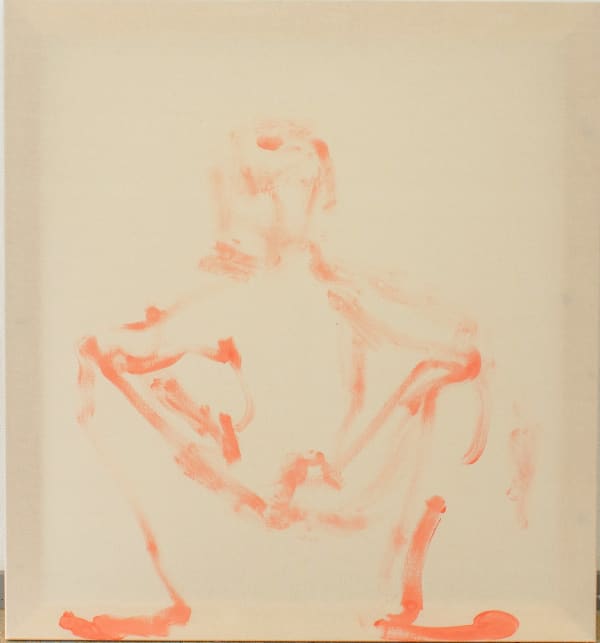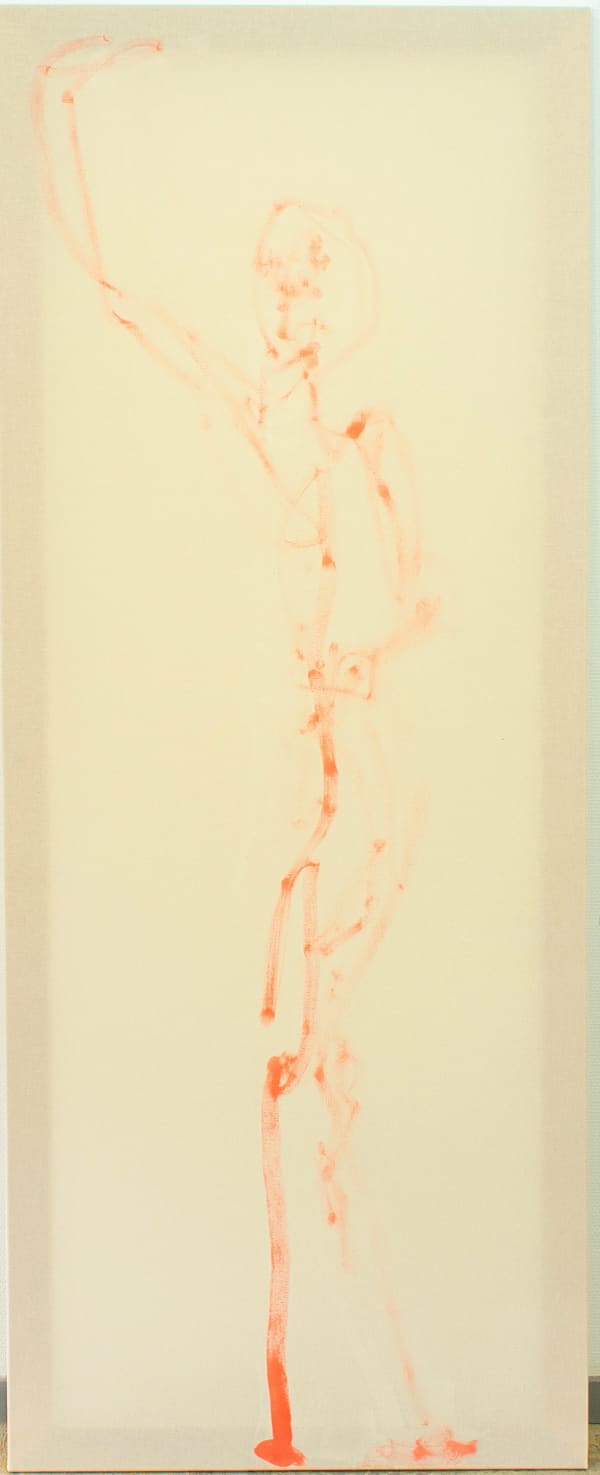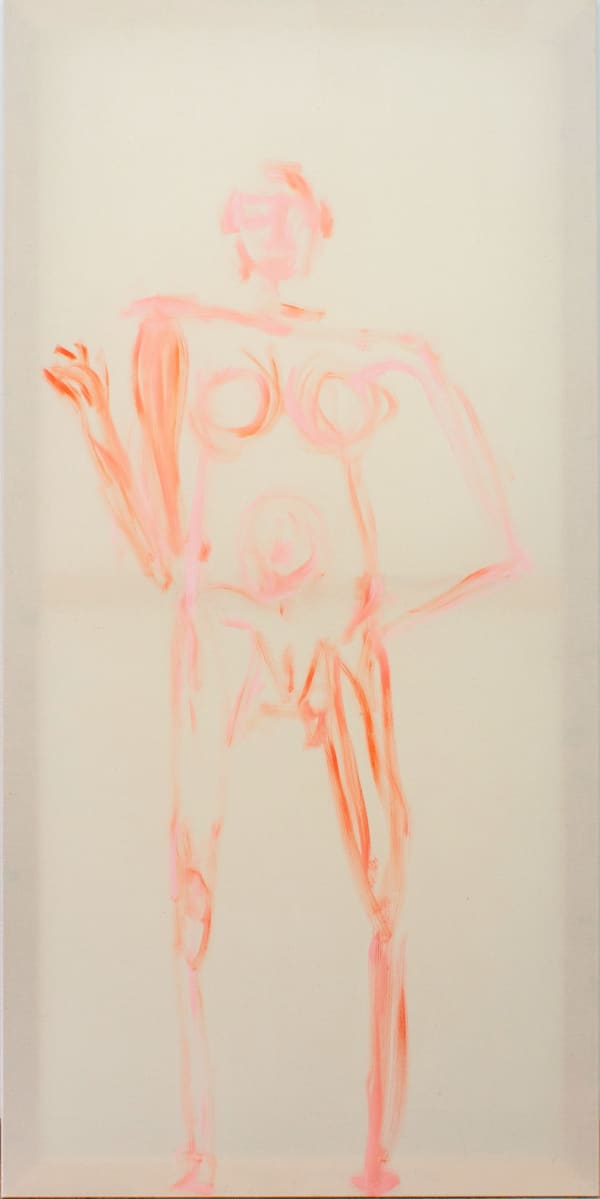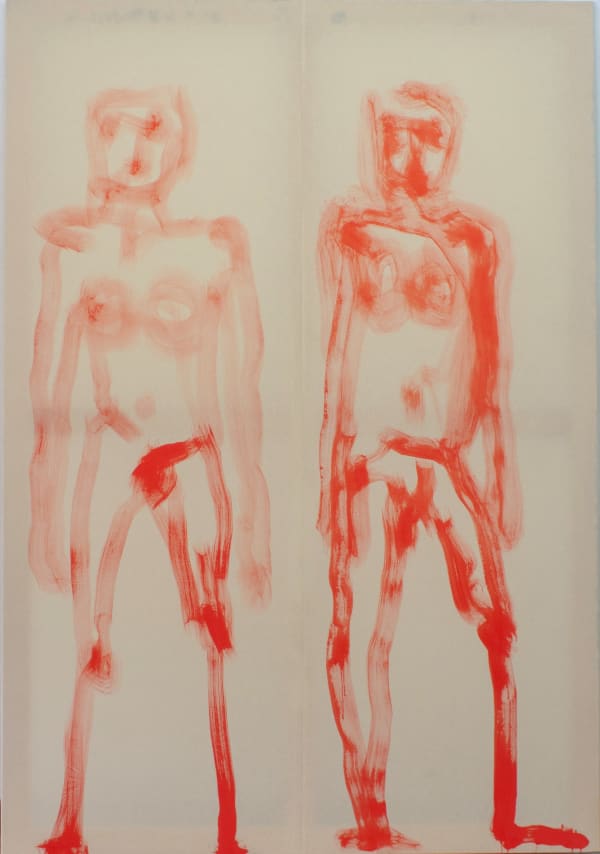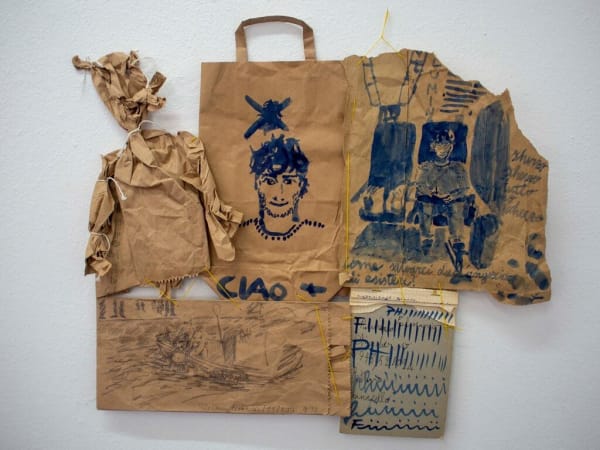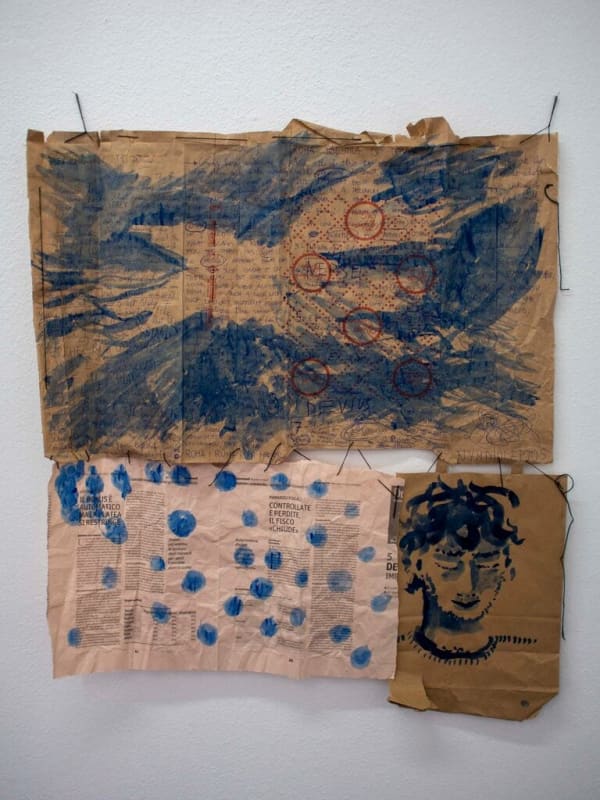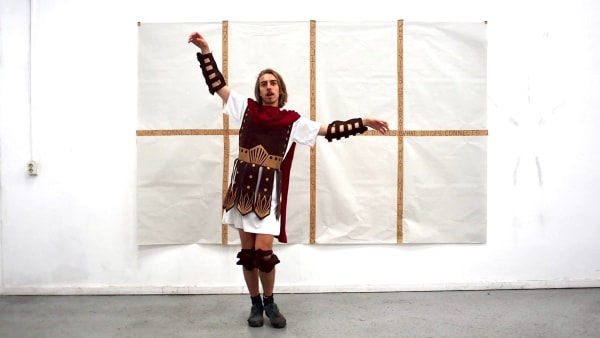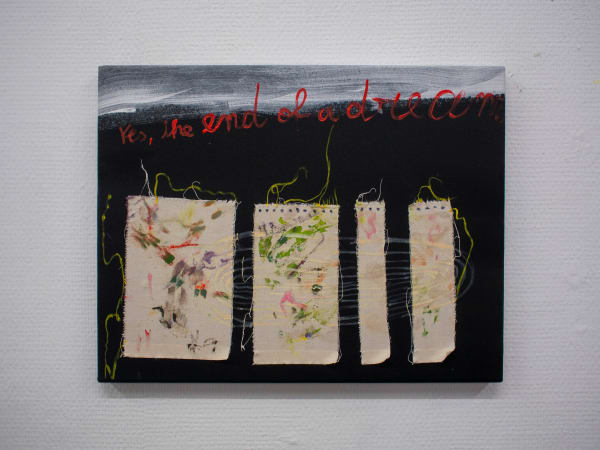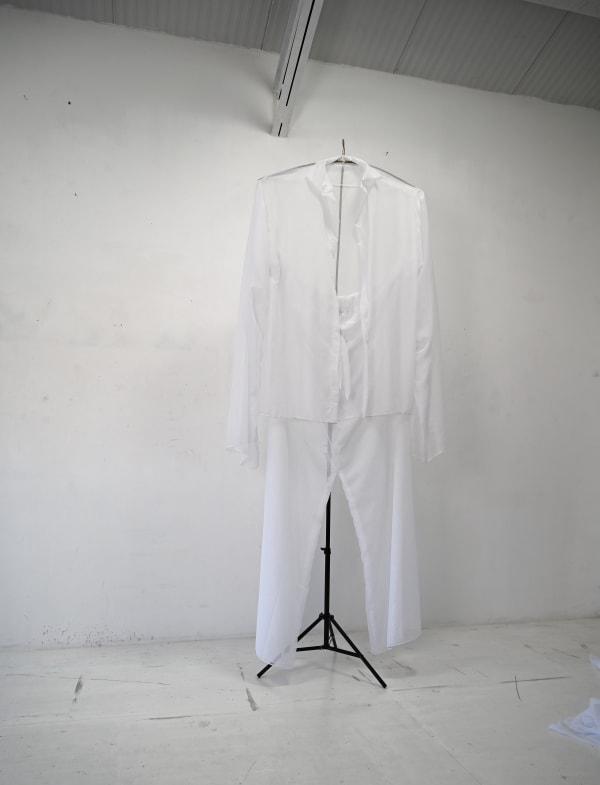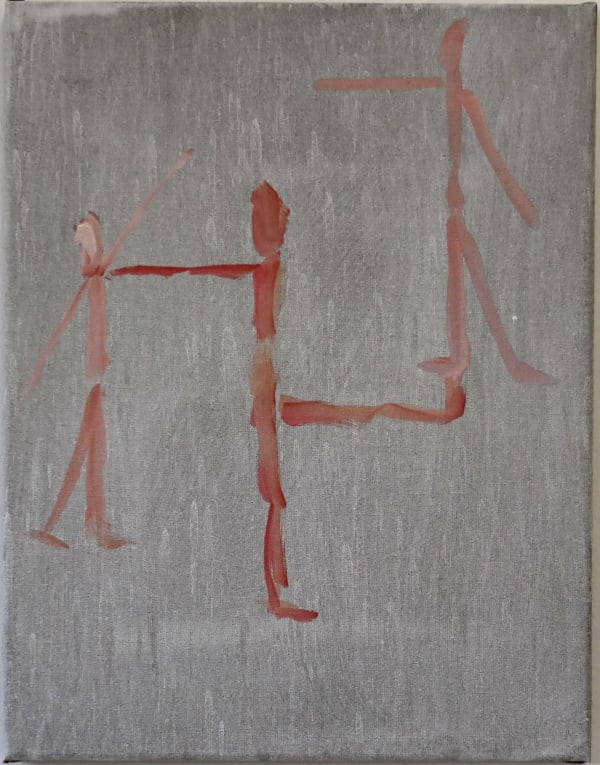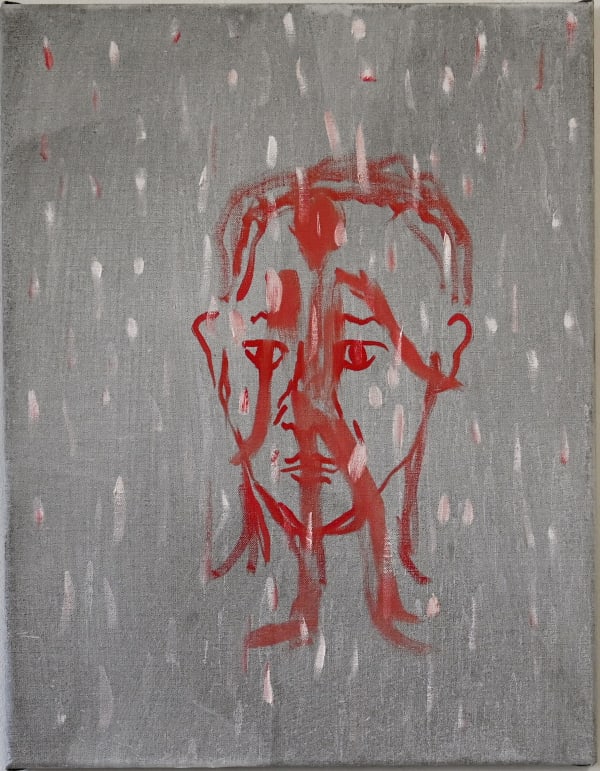We are pleased to return to June Art Fair 2025 with a duo presentation by Daniele Formica (Italy, 1996) and Klaas Kloosterboer (The Netherlands, 1959). Together, Formica and Kloosterboer dialogue about the presence and absence of the human figure across painting, sculpture, and video. They explore the physicality of the body both in its movement and stillness, either straightforwardly depicting it or lyrically evoking it.
As part of Garden Cinema, a June Art Fair x Provence magazine collaboration, we present El Cristal es Mi Piel (2025) by Pauline Boudry/Renate Lorenz and Super Taboo (2016) by Su Hui-Yu.
-
 Daniele Formica, Squatting Pause, 2025
Daniele Formica, Squatting Pause, 2025 -
 Daniele Formica, Bowing forward, hand on bent knee, 2025
Daniele Formica, Bowing forward, hand on bent knee, 2025 -
 Daniele Formica, Kneeling Pause, 2025
Daniele Formica, Kneeling Pause, 2025 -
 Daniele Formica, Sitting on the floor, elbow up (individual pose), 2025
Daniele Formica, Sitting on the floor, elbow up (individual pose), 2025 -
 Daniele Formica, Standing Pause (an individual gesturing), 2025
Daniele Formica, Standing Pause (an individual gesturing), 2025 -
 Daniele Formica, Standing Pause (an individual), 2025
Daniele Formica, Standing Pause (an individual), 2025 -
 Daniele Formica, Two Standing Pauses (a couple), 2025
Daniele Formica, Two Standing Pauses (a couple), 2025 -
 Daniele Formica, Paper bag 2: Come salvarci dall’angoscia di esistere?, 2022
Daniele Formica, Paper bag 2: Come salvarci dall’angoscia di esistere?, 2022 -
 Daniele Formica, Paper Bag 1: Nympholepsy, 2022
Daniele Formica, Paper Bag 1: Nympholepsy, 2022 -
 Daniele Formica, Love will tear us apart, 2022
Daniele Formica, Love will tear us apart, 2022 -
 Daniele Formica, Boys, 2023
Daniele Formica, Boys, 2023 -
 Daniele Formica, The end of a dream, 2023
Daniele Formica, The end of a dream, 2023 -
 Klaas Kloosterboer, 25163, 2025
Klaas Kloosterboer, 25163, 2025 -
 Klaas Kloosterboer, 25166, 2025
Klaas Kloosterboer, 25166, 2025 -
 Klaas Kloosterboer, 25165, 2025
Klaas Kloosterboer, 25165, 2025 -
 Klaas Kloosterboer, 25167, 2025
Klaas Kloosterboer, 25167, 2025 -
 Klaas Kloosterboer, 25168, 2025
Klaas Kloosterboer, 25168, 2025 -
 Pauline Boudry / Renate Lorenz, El Cristal en Mi Piel (Glass is My Skin) , 2025
Pauline Boudry / Renate Lorenz, El Cristal en Mi Piel (Glass is My Skin) , 2025 -
 Su Hui-Yu, Super Taboo (超級禁忌), 2016
Su Hui-Yu, Super Taboo (超級禁忌), 2016
-
 Portait of Daniele Formica
Portait of Daniele FormicaDaniele Formica
Daniele Formica (Perugia, 1996) lives and works in The Hague. He received the Fine Arts Bachelor Award at the Koninklijke Academie van Beeldende Kunsten (KABK). Daniele Formica's work comes from the impulse to internalize and repurpose the universe to its people. Combining cross-disciplinary knowledge and everyday banality, he composes a repertoire of linguistic revelations, schizophrenic theories, and poetic claims. Daniele Formica's practice could be described as cartographic, as he superimposes layer upon layer of cognitive, emotional, and ontological entanglements onto vulnerable mapping exercises that ultimately form a complex artistic atlas. In his work, oftentimes drawing from classical literature, language enunciates thought while tracing coordinates in his entropic mind. Words, as if entries on a diary, emerge from his vital experience and create linguistic rhythms of repetition and alternation wherein to gather and position fragmented identities and knowledge. -
 Portrait of Klaas Kloosterboer
Portrait of Klaas KloosterboerKlaas Kloosterboer
Klaas Kloosterboer's (1959, Noord/Zuid Schermer) wide-ranging work consistently bridges the gap between abstraction and action. By questioning the elements of painting and its display, he confronts the viewer with the painting process. Rather than illustrating thoughts, his work is often an act in and of itself. As such, Kloosterboer’s work is always rooted in an action. He might determine a place on the canvas through cutting, sewing and throwing paint. Sometimes you see a suspended life-size, hand-sewn linen costume; a series of painted boxes; or even a video depicting the view through a car’s rear window as it pulls two giant balls down a road. Kloosterboer’s work is dynamic, idiosyncratic and lucid.
The artistic actions of creating space and - in a counter-move - occupying space represent the fundamental driving forces behind Kloosterboer'spractice. The roots of his oeuvre stand in relation to the developments of avant-garde painting in the twentieth century, especially to its abstract and conceptual experiments. Kloosterboer is attracted to the purism of historical Modernism, but at the same time he remains skeptical with regard to purisms of all sorts. For him rules in art possess only a relative meaningfulness. In creating his works, he utilizes the materials and techniques of the painter. He works with various abstract-visual languages, with the figure-ground problem, the painterly gesture. He brings changes to these conventional categories, however, with the goal of ushering them into the here and now. Kloosterboer's work is ceaselessly concerned with contemporaneity, with the creation of a world of artifacts which, in its ritual elements, is in no way separate from the self-evident verities of the material world. Art ought to continue to lay claim to its own autonomous space for trial arrangements.
Recent solo exhibitions include Sunscape, Galeria Structura, Sofia, 2024; Rephrase, Revise, Replace, MNAC, Bucharest, 2023; The Rules and the Game, Kröller Müller Museum, Otterlo, 2022; Act between sliding doors, Hedge House, Kasteel Wijlre, Wijlre, 2021. His work is in the collections of Centraal Museum, Utrecht; Museum Boijmans van Beuningen, Rotterdam; Stedelijk Museum, Amsterdam; Museum Voorlinden, Wassenaar; Rijksmuseum, Amsterdam; Kröller Möller Museum, Otterlo, among others.
-

Pauline Boudry/Renate Lorenz
Pauline Boudry and Renate Lorenz have been working together in Berlin since 2007. They produce installations that choreograph the tension between visibility and opacity. Their films capture performances in front of the camera, often starting with a song, a picture, a film or a score from the near past. They upset normative historical narratives and conventions of spectatorship, as figures and actions across time are staged, layered and re-imagined. Their performers are choreographers, artists and musicians, with whom they are having a long-term conversation about the conditions of performance, the violent history of visibility, the pathologization of bodies, but also about companionship, glamour and resistance.
Recently, they have shown their work at the 35th São Paulo Art Biennal, Crystal Palace/Reina Sofia Museum Madrid, Seoul Mediacity Biennale, Whitechapel Gallery London, the Hammer Museum Los Angeles, Centre Pompidou Paris, Seoul Museum of Art, Van Abbemuseum Eindhoven, New Museum New York, Julia Stoschek Collection Berlin or 58th Biennale di Venezia (Swiss Pavillon).
Their work is found in the collections of Centre Pompidou Paris, Tate Modern London, Van Abbe Museum Eindhoven, GAM/Rivoli Torino, NGV Museum Melbourne, Reina Sofia Museum Madrid, Kadist Foundation, Frac Lorraine, Kunsthaus Zürich, NBK Berlin, Warsaw Museum, MCBA Lausanne, Frac Toulouse, Walker Art Gallery Liverpool, Nouveau Musée Monaco, Bundes Sammlung Deutschland, Frac Bretagne, Louisiana Museum Dennmark, Lodz Museum, CA2M Madrid, and Philadelphia Museum of Art, among others.
-
Su Hui-Yu

SU (Su Hui-Yu) explores the connection between mass media, pop culture, memories of martial law and the post-colonial history of Taiwan and East Asia. His “Re-shooting” series centers around Taiwanese and East Asian history, memory, re-imagination and transgression. His recent projects engage collective memories and ideologies while exploring the mechanism of oppression and liberation tied to Taiwan cultural values. He obtained an MFA from Taipei National University of the Arts in 2003, and has remained active in the contemporary art scene and the film society ever since.
SU’s works have been exhibited at renowned exhibitions, festivals, and art institutes, including MOCA Taipei, Taipei Fine Arts Museum, Kaohsiung Museum of Fine Arts, Casino Luxembourg, Bangkok Arts and Culture Center, Kunsthalle Winterthur (Switzerland), San Jose Museum of Art (California, USA), Curitiba International Biennial of Contemporary Art (Brazil), 1646 Art Space (Den Haag, The Netherlands) and Power Station of Art (Shanghai, China), the International Film Festival Rotterdam, Taipei Golden Horse Film Festival, Singapore International Film Festival, the Videonale (Germany), PERFORMA (New York, USA), RISING (Melbourne). In 2017, International Film Festival Rotterdam dedicated a retrospective to SU’s video works, while his video work Super Taboo had its world premiere in the Tiger Awards Competition for Short Films. From the summer of 2023, Su’s new project The Space Warriors series has been tour exhibited at Hyundai ArtLab in Seoul for the finalist of the 5th VH Art Award, ARS Electronica in Linz, Kunstsammlungen am Theaterplatz in Germany, and Casino Luxembourg. The same year in May, Su’s biggest museum solo The Trio Hall was exhibited in MOCA Taipei, curated by Eugenio Viola. In 2025, The Trio Hall participated in the Forum section of the 75th Berlinale as a feature film (World premiere).

